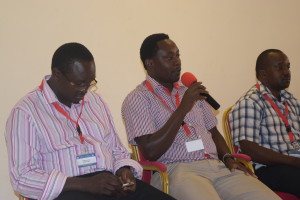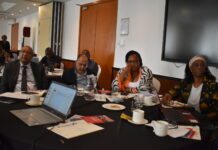By Mary Mwendwa
Getting young people interested in science for a better tomorrow, is critical for Kenya.
Yet there has to be a love and patience with science, notes this young researcher keen to understand the animal-human bond and disease transmission to man, through inclusive field studies.
At 34 years, Thumbi Mwangi is a Clinical Assistant Professor at the Paul G. Allen School for Global Animal Health, Washington State University and believes that the veterinarian’s role is to maximize the potential of the relationship between people and animals to promote the health and well-being of both.
“Peoples’ health is intricately related to that of the animals they own, and of the wildlife they interact with,” says Dr Thumbi in an interview .
And with three out of five of all human diseases originating from animals, Dr Thumbi is calling for more grounded scientific discussions in Kenya on the interactions between animals and man, and their health effect on the latter.

“It is critical to view animals both from the good and the bad angles with a focus to capitalize on the positives and reduce the negative effects,” he added.
Dr Thumbi appreciates that veterinary medicine serves society fulfilling both human and animal needs thus he has dedicated his time to understanding the thin line between the illnesses in human and animal worlds.
But what drove him to complete a PhD at 32 years?
He believes that his love for the animal world was nurtured in a small village, Endarasha in Nyeri where cattle, sheep, dogs and other domestic animals were not only companions as he grew up, but also significant members of their homestead.
As a student at St Martin’s Primary School and later at Njiiri High School, he knew his calling was driven towards finding solutions beyond the illnesses he had seen the domestic animals, sometimes dying from.
He traces his turning point towards becoming a scholar early on during his Bachelor in Veterinary Medicine and Surgery degree training, to interactions with Prof. Kiama Gitahi, then the Associate Dean for Faculty of Veterinary Medicine and now director of the Wangari Maathai Institute at the University of Nairobi.
“In 2001, Prof. Kiama had just returned from Switzerland after attaining his PhD, and was teaching us Anatomy in a new and interesting way. In one of our class assessments, I think he liked the answers I gave him and he wrote the famous – come see me – on my answer sheet, and the rest is history. He introduced me to the ideas of research and academia, and mentored me through Vet School and remains a good friend to-date”
And just like a young seedling takes to water, Thumbi took up the challenge and while still in veterinary school got as much exposure to the veterinarians world as he could, including at the Kenya Wildlife Service, where he was part of teams that travelled to the Maasai Mara to treat sick cheetahs, working at the Solio ranch and wildlife conservancy, and even taking a bus trip to Botswana to work in a small animal Veterinary clinic in Gaborone.
“I wasn’t lucky to get an attachment in a research institution during my undergraduate studies, but was certain research and academia would be my career path” he adds.
He was however fortunate to get a string of scholarships starting with a graduate scholarship from UoN, research fellowship from Association for Strengthening Agriculture Research in East and Central Africa to work at International Livestock Research Institute, and a PhD scholarship from the Wellcome Trust to study disease patterns and control at the University of Edinburgh.
“I have been fortunate to have had really good mentors from Dr. Francis McOdimba during my masters, Prof. Mark Woolhouse for my PhD, and Professors Njenga Kariuki and Guy Palmer during my post-doctoral research work. These gentlemen have been fantastic and I owe much of my scientific thinking to their guidance”
But he was not after these titles from these prestigious learning institutions; it was the passion of being part of solutions to improve human health by understanding the animal world and the cross –link between the two worlds.
Dr Thumbi terms the risk of emerging infections that may infect millions of people across geographic regions within short times as the greatest current public health scare but calls for a clearer understanding of the origins of animal diseases and effectively managing them.
“Whereas this is a real threat, there are numerous other diseases of animal origin that are not as dramatic but continue to exert huge disease burdens on people especially those in marginalized areas. We have diseases such as brucellosis mainly transmitted through unpasteurized milk, rabies disease transmitted by rabid dogs, and anthrax caused by the consumption of uninspected meat which has become quite common news in Kenya.
It is these neglected diseases that Dr. Thumbi, who is also a visiting lecturer at the Wangari Maathai Institute for Environmental Studies and Peace, UoN and a researcher at Kenya Medical Research Institute, wants to see eliminated or better controlled.
The highlight of his current research aims at not only providing good surveillance and enhancing preparation and response to the big scare epidemic-causing diseases, but to also deal with the neglected zoonotic diseases that are hugely important in most rural areas.
For young researchers keen on having plaques of their name synonymous with ground breaking scientific findings, he urges them to be accommodative to positive criticism in the world of research.
“You need to have thick skin for criticism and desire to learn. Science progresses when ideas are challenged and it’s through such experiences that you learn from colleagues,” Dr Thumbi adds.
Yet it doesn’t begin and end with challenging ideas.
Dr Thumbi adds that young researchers with good mentors have a great chance of success, and this is linked to ability to do good science and access funding which are the right ingredients for growth in science.
“Universities would benefit from investing more in research faculty and not just teaching lecturers. This should increase exposure for their undergraduate students early on in their training, and provide good mentorship to their graduate students,” he adds. Postdoctoral researchers are the main drivers of research in all major institutions globally, yet these positions are very rare in our universities. PhD holders are often led back to class and loaded with undergraduate classes to teach, leaving little room to develop themselves into internationally competitive scientists.” he pointed out.
However, he believes that as a country and a continent , there should be more investment in sciences to find solutions that generally improve human health welfare and opportunities.
“We need more monies to be made available to universities and research institutions. To date local funding for science and technology is still grossly insufficient. I am hopeful that African leaders will see the need for more resources being channeled to research, and philanthropy will increasingly look into funding science and the solutions it presents”
“For the epidemic diseases, my priority is to work to strengthen surveillance so that we can catch the bad diseases early enough when they are still in animals before they start spreading to humans,” he says adding that this will make it cheaper and will save lives.
We are looking for innovative ways to keep the burden of zoonotic diseases negligible, from surveillance systems to interventions such as use of vaccines that have been shown to significantly reduce the burden of infectious diseases.
For his PhD, Dr Thumbi tested the hypothesis whether parasites co-infecting an individual work together to harm the host more, or against each other to harm the host less to the benefit of the infected individual.
“We found that for instance in cattle, having a high number of worms greatly increased the chances of dying from East Coast Fever – which is the main livestock killer in sub-Saharan Africa,” Dr Thumbi adds.
East Coast Fever is a disease transmitted by ticks infected with a protozoan parasite referred to as Theileria parva (much like malaria for cows).
“Even more interesting was the finding that infection with another parasite (Theileria mutans) that is closely related to the one causing East Coast fever, greatly protected the animals from the disease offering up to 80 per cent protection from the disease – almost as good as a highly effective vaccine,” Dr Thumbi added..
Currently, with a team of other researchers, Dr Thumbi is following on these findings, and has received a grant from the Bill & Melinda Gates Foundation to determine if deworming reduces the risk of ECF disease in cattle, and malaria in children.
“We are working to determine the mechanisms by which certain parasite infections may be protective against lethal ones – with the promise of possibly exploiting the findings for the control of diseases,” he added.
Away from the research desk and frequent travels on field visits, Dr Thumbi is an avid traveler and passionate photographer keen to see the outdoor intricacies through his lens, and treasures the time spent with his trio; wife, daughter and son.
His favorite book is the Bible, it has the science, history, arts, drama, motivation, purpose and life skills for a lifetime, all in one.
“I owe it to my dad Mwangi Wambuthia for some of my interest in disease. When growing up with my brothers, he made us daily palpate the lymph nodes of all new born calves until the day they first had their lymph nodes swell – which would mean they had got the first infection of East Coast fever (ECF) disease, the number one killer of livestock in East Africa. If you catch ECF early, indicated by swelling lymph nodes, and treat without delay, survival of the animals is almost always assured. In fact that simple technique is what researcher’s are using today in the control of ECF through the infection and treatment method vaccine – where they infect the animal with the disease and treat immediately as opposed to waiting for the natural infection in the field as we did.”















this very good article and i hope young people will take more interest and science and they will aware the people from modern problems related health. Mary you are doing a noble job .
Comments are closed.